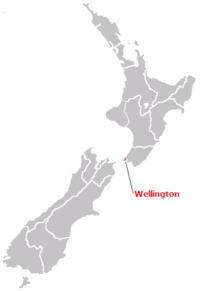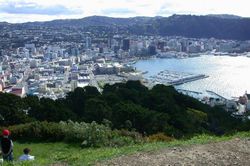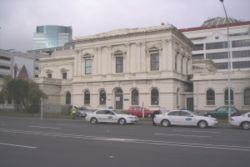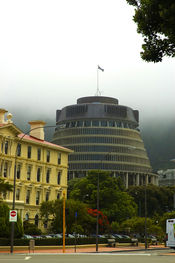Wellington
2007 Schools Wikipedia Selection. Related subjects: Geography of Oceania (Australasia)
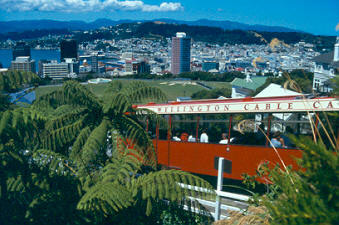 |
|
|---|---|
| The Wellington Cable Car and city centre. | |
| Location | |
| Wellington shown within New Zealand Coordinates: |
|
| Government | |
| Country: | New Zealand |
| Region: | Wellington |
| Regional Council: | Greater Wellington Regional Council |
| Territorial Authorities: | Wellington City Council Hutt City Council Upper Hutt City Council Porirua City Council |
| Population (2005) | |
| Urban Area: | 370,000 |
| Four cities: | 374,000 |
| Wellington City: | 182,600 |
| Wellington Region: | 460,400 |
| Time Zone | |
| Standard: | NZST (UTC +12) |
| Daylight Saving: | NZDT (UTC +13) |
Wellington (Te Whanganui-a-Tara or Poneke in Māori) is the capital of New Zealand, the country's second largest urban area and the most populous national capital in Oceania. It is in the Wellington Region at the southern tip of the North Island, near the geographical centre of the country.
Like many cities, Wellington's urban area extends well beyond the boundaries of a single local authority. Greater Wellington or the Wellington Region means the entire urban area, plus the rural parts of the cities and the Kapiti Coast, and across the Rimutaka Range to the Wairarapa.
Wellington has roughly the same urban area population as Canberra in Australia.
Wellington was named in honour of Arthur Wellesley, the first Duke of Wellington and victor at the Battle of Waterloo. The Duke's title comes from the town of Wellington in the English county of Somerset.
In Māori Wellington goes by two names. Te Whanganui-a-Tara refers to Wellington Harbour and means "the great harbour of Tara". The alternative name Pōneke is often discouraged because of a belief that it is nothing more than a transliteration of the harbour's former nickname in English, Port Nick, short for Port Nicholson.
Wellington is New Zealand's political centre, housing Parliament and the head offices of all government ministries and departments.
Wellington's compact city centre supports an arts scene, café culture and nightlife much larger than most cities of a similar size. It is a centre of New Zealand's film and theatre industry. Te Papa Tongarewa (the Museum of New Zealand), the New Zealand Symphony Orchestra, the Royal New Zealand Ballet and the biennial International Festival of the Arts are all sited there.
Wellington has the 12th best quality of living in the world, according to a 2006 study by consulting company Mercer. Of cities with English as the primary language, Wellington ranked fourth. 1
Settlement
Māori who originally settled the Wellington area knew it as Te Upoko o te Ika a Māui, meaning "the head of Māui's fish". Legend recounts that Kupe discovered and explored the district in about the tenth century.
European settlement began with the arrival of an advance party of the New Zealand Company on the ship Tory, on 20 September 1839, followed by 150 settlers on the ship Aurora on 22 January 1840. The settlers constructed their first homes at Petone (which they called Britannia for a time) on the flat area at the mouth of the Hutt River. When that proved swampy and flood-prone they transplanted the plans without regard for a more hilly terrain. Wellington has some extremely steep streets running straight up the sides of hills.
Earthquakes
Wellington suffered serious damage in a series of earthquakes in 1848 and from another earthquake in 1855. The 1855 Wairarapa earthquake occurred on a fault line to the north and east of Wellington. It ranks as probably the most powerful earthquake in recorded New Zealand history, with an estimated magnitude of at least 8.2 on the Richter scale. It caused vertical movements of two to three metres over a large area, including raising an area of land out of the harbour and turning it into a tidal swamp. Much of this land was subsequently reclaimed and is now part of Wellington's central business district. For this reason the street named Lambton Quay now runs 100 to 200 metres from the harbour. Plaques set into the footpath along Lambton Quay mark the shoreline in 1840 and thus indicate the extent of the uplift and of subsequent reclamation.
The area has high seismic activity even by New Zealand standards, with a major fault line running through the centre of the city, and several others nearby. Several hundred more minor fault lines have been identified within the urban area. The inhabitants, particularly those in high-rise buildings, typically notice several earthquakes every year. For many years after the 1855 earthquake, the majority of buildings constructed in Wellington were made entirely from wood. The 1996-restored Government Buildings, near Parliament and the Railway Station, comprise the largest wooden office building in the Southern Hemisphere. While masonry and structural steel have subsequently been used in building construction, especially for office buildings, timber framing remains the primary structural component of almost all residential construction. Residents also place their hopes of survival in good building regulations, which gradually became more stringent in the course of the 20th century.
New Zealand's capital
In 1865 Wellington became the capital of New Zealand, replacing Auckland, where William Hobson had established his capital in 1841. Parliament first sat in Wellington on 7 July 1862, but the city did not become the official capital for some time. In November 1863 the Premier Alfred Domett moved a resolution before Parliament (in Auckland) that "... it has become necessary that the seat of government ... should be transferred to some suitable locality in Cook Strait." Apparently there was concern that the southern regions, where the gold fields were located, would form a separate colony. Commissioners from Australia (chosen for their neutral status) pronounced the opinion that Wellington was suitable because of its harbour and central location. Parliament officially sat in Wellington for the first time on 26 July 1865. The population of Wellington was then 4,900 .
Wellington is also the seat of New Zealand's highest court, the Supreme Court of New Zealand. The historic former High Court building is to be refurbished for the court's use.
Government House, the official residence of the Governor-General, is in Newtown, opposite the Basin Reserve.
Location and geography
Wellington stands at the south-western tip of the North Island on Cook Strait, the passage that separates the North and South Islands. On a clear day the snowcapped Kaikoura Ranges are visible to the south across the strait. To the north stretch the golden beaches of the Kapiti Coast. On the east the Rimutaka Range divides Wellington from the broad plains of the Wairarapa, a wine region of national acclaim.
Wellington is the southernmost national capital city in the world, with a latitude about 41°S. It is more densely populated than most other settlements in New Zealand, due to the small amount of building space available between the harbour and the surrounding hills. Because of its location in the roaring forties latitudes and its exposure to omnipresent winds coming through Cook Strait, the city is known to Kiwis as "Windy Wellington".
More than most cities, life in Wellington is dominated by its central business district. Approximately 62,000 people work in the CBD, only 4,000 fewer than work in Auckland's CBD, despite that city having three times Wellington's population. Wellington's cultural and nightlife venues concentrate in Courtenay Place and surroundings located in the southern part of the CBD, making the inner city suburb of Te Aro the largest entertainment destination in New Zealand.
Wellington has the highest average income of a main urban area in New Zealand and the highest percentage of people with tertiary qualifications.
Wellington has a reputation for its picturesque natural harbour and green hillsides adorned with tiered suburbs of colonial villas. The CBD is sited close to Lambton Harbour, an arm of Wellington Harbour. Wellington Harbour lies along an active geological fault, which is clearly evident on its straight western coast. The land to the west of this rises abruptly, meaning that many of Wellington's suburbs sit high above the centre of the city.
There is a network of bush walks and reserves maintained by the Wellington City Council and local volunteers. The Wellington region has 500 square kilometres of regional parks and forests.
In the east is the Miramar Peninsula, connected to the rest of the city by a low-lying isthmus at Rongotai, the site of Wellington International Airport. The narrow entrance to Wellington is directly to the east of the Miramar Peninsula, and contains the dangerous shallows of Barrett Reef, where many ships have been wrecked (most famously the inter-island ferry Wahine in 1968).
On the hill west of the city centre are Victoria University and Wellington Botanic Garden. Both can be reached on a funicular railway, the Wellington Cable Car.
Wellington Harbour has three islands: Matiu/Somes Island, Makaro/Ward Island and Mokopuna. Only Matiu/Somes Island is large enough for settlement. It has been used as a quarantine station for people and animals and as an internment camp during the First and Second World Wars. It is now a conservation island, providing refuge for endangered species, much like Kapiti Island further up the coast. There is access during daylight hours by the Dominion Post Ferry.
The city averages 2025 hours of sunshine per annum.
Energy
The energy needs of Wellington are increasing, one likely source is from the wind, and a large farm is proposed for that purpose. The project will consist of 70 turbines with a maximum capacity of 210 MW, just a few kilometres to the south-west of Wellington CBD, between Makara Beach and Cape Terawhiti.
Demographics
The population of Wellington, including the outlying areas, is approaching 400,000. In the 2001 census, 18.5% of people were under 15, compared with 22.7% for New Zealand. About 8.6% of people were aged 65 and over, compared with 12.1% for New Zealand. 85.6% of people in Wellington city said they are of European ethnic origin. Around 4.1% are Māori, with the remainder being of Pacific Islander, Asian or other ethnicity.
Arts and culture
Wellington is the arts and culture capital of New Zealand, and is the centre of the nation's film industry. Peter Jackson, Richard Taylor, and a growing team of creative professionals have managed to turn the eastern suburb of Miramar into one of the world's finest film-making infrastructures. Directors like Jane Campion and Vincent Ward have managed to reach the world's screens with their independent spirit. Emerging Kiwi film-makers, like Taika Waititi, Charlie Bleakley, Costa Botes and Jennifer Bush-Daumec, are extending the Wellington-based lineage and cinematic scope.
Wellington is home to Te Papa Tongarewa (the Museum of New Zealand), the national opera company, New Zealand Symphony Orchestra, City Gallery, Chamber Music New Zealand, Royal New Zealand Ballet, St. James' Theatre, Downstage Theatre, Bats Theatre and Arts Foundation of New Zealand.
The once-prosaic capital has become home to dozens of high-profile events and cultural celebration. The city now hosts a biennial International Festival of the Arts, annual International Jazz Festival, and major events such as Cuba Street Carnival, New Zealand Fringe Festival, Summer City, New Zealand Affordable Art Show, numerous film festivals, and World of Wearable Art. Many of the city's neighbourhoods and ethnic communities also host annual festivals, all helping transform the city into the envy of New Zealand.
The local music scene, on the success of bands like The Phoenix Foundation, Shihad, Fat Freddy's Drop, and The Black Seeds has become a diverse and thriving pool of talent. The New Zealand School of Music was established in 2005 through a merger of the conservatory and theory programmes at Massey University and Victoria University.
Poet Bill Manhire, director of the International Institute of Modern Letters, has turned the Creative Writing Programme at Victoria University into a forge of new literary activity. Te Whaea, New Zealand's university-level school of dance and drama, and tertiary institutions such as The Learning Connexion, offer training and creative development for the next generation. Wellington underground poets broke new ground in creative expression in the 1980s and 1990s.
The city's new Arts Centre, Toi Poneke, serves as a nexus of creative projects, collaborations, and multi-disciplinary production. Arts Programmes and Services Manager Eric Holowacz and a small team based in the Abel Smith Street facility have produced ambitious new initiatives such as Opening Notes, Drive by Art, the annual Artsplash Festival, and new public art projects.
As a capital city, Wellington is home to diplomatic missions with cultural officers ready to interface with these aspects of the City's life. In the early part of the 21st century, Wellington has confirmed its place as a vibrant centre of arts, culture, and creativity in the South Pacific.
Sport
Wellington is the home to:
- The Hurricanes — Super 14 rugby team
- Wellington Lions — Air New Zealand Cup (formerly NPC) rugby team
- Wellington Firebirds - cricket team
- Wellington Orcas - Bartercard Cup team
- Capital Shakers — The National Bank Cup netball team
- Team Wellington - Wellington's franchise in the New Zealand Football Championship
- Wellington Saints - The National Basketball League basketball team
Sporting events hosted in Wellington include:
- Wellington Sevens - A round of the IRB Sevens World Series. Held at the Westpac Stadium over a weekend every February, this rugby sevens tournament brings more than 25,000 visitors and contributes over $8 million to the local economy each year.
- a Wellington 500 street race for touring cars, between 1985 and 1996.
- the World Mountain Running Championships in 2005.
Notable Wellingtonians
- Ivan Bootham - novelist, short story writer, poet and composer
- Jane Campion — Oscar winning film-maker
- Sir Robin Cooke, Baron Cooke of Thorndon (dec) - barrister and jurist
- Russell Crowe — Oscar-winning actor
- Rod Drury - technology entrepreneur
- Lauris Edmond (dec) — poet
- Peter Jackson — Oscar-winning film-maker
- Katherine Mansfield (dec) — writer
- Jack Marshall (dec) — former Prime Minister
- Anna Paquin - Oscar-winning actress
- William Hayward Pickering (dec) — electrical engineer, former head of the Jet Propulsion Laboratory in California
- Antonia Prebble - actress
- John Psathas - composer
- Jonathan Sarfati - chess master and author, raised in Wellington
- Tom Scott - cartoonist, political commentator
- Richard Taylor — head of film prop and special effects company Weta Workshop, owned by Peter Jackson. Multiple Oscar winner.
- Jon Toogood — singer and guitarist for the rock band Shihad
- Tana Umaga — former captain of the All Blacks
- Karl Urban — actor
